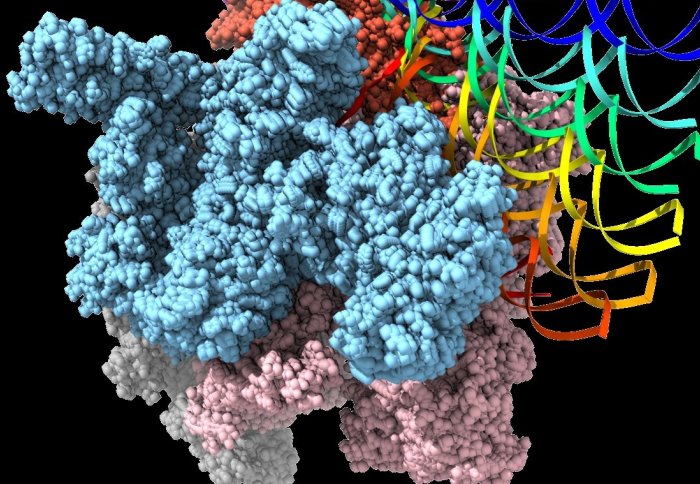New insights into DNA ‘melting’ reveal chink in bacteria’s armour
by Kate Wighton

Proteins interacting with DNA
Scientists have shed light on DNA ‘melting’ – a crucial process fundamental to all life.
The researchers, from Imperial College London, who used bacteria in their experiments, say these findings may provide new insights into eradicating harmful bugs.
How DNA melts is a fundamental part to all life – bacterial and human Professor Xiaodong Zhang Study author
DNA encodes information to make proteins, which are key to all processes in life. The DNA molecule is composed of two complementary strands, which are normally wrapped around each other in a helical structure.
When a cell wants to make proteins, the strands need to be pulled apart or 'melted' first, before a fundamental cellular process called transcription takes place.
Because transcription also takes place in human cells, the new findings may provide insights for conditions such as cancer and other diseases.
But although this DNA melting process is fundamental to life, scientists are still in the dark about the intricate details of how the cell’s machinery captures and reads the DNA.
In the new research, published in Molecular Cell, the team used an extremely powerful technique called cryo-electron microscopy to physically see how the DNA melting process happens in detail.
Shape-shifting molecule
The experiments focused on a molecule called RNA polymerase, that captures and pulls apart the DNA, before reading the sequence in the melted out DNA strand to make a molecule called RNA.
This is then used as a template to make proteins. The findings revealed that the RNA polymerase molecule changes shape in a dramatic fashion when it locks onto DNA.
This shape-shifting allows it to capture and ‘melt’ the DNA at the same time.
Previously, researchers were unclear if RNA polymerase captured the DNA before unwinding the strands, or if DNA is melted out first before fully captured by the RNA polymerase. Now their new finds reveal these two events are integrated processes.
Professor Xiaodong Zhang, lead author of the study from the Department of Medicine, said these insights may help scientists design more effective antibiotics.
The results may also have implications for gene-editing techniques such as CRISPR Professor Martin Buck Study author
“How DNA melts is a fundamental part to all life – bacterial and human. Now that we know how RNA polymerase changes it shape to melt the DNA, this opens avenues for interfering with this pathway – and stopping bacterial growth.”
And because this protein production system is the same in humans, these findings may also provide clues into disease, explained co-author Professor Martin Buck, from the Department of Life Sciences.
“Protein production can become dysregulated in diseases such as cancer, and these findings could give us greater understanding of how this can happen. The results may also have implications for gene-editing techniques such as CRISPR, which allows scientists to insert or remove genes - as these require targeted gene melting.”
-
"Structures of bacterial RNA Polymerase complexes reveal mechanism of DNA loading and transcription initiation" by R.Glyde et al. is published in Molecular Cell.
The study was funded by the Biotechnology and Biological Sciences Research Council and the Wellcome Trust, with support from the BBSRC DTP studentship programme.
Article supporters
Article text (excluding photos or graphics) © Imperial College London.
Photos and graphics subject to third party copyright used with permission or © Imperial College London.
Reporter
Kate Wighton
Communications Division